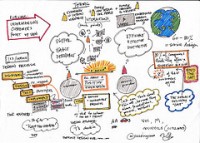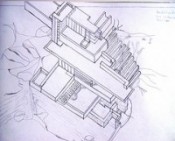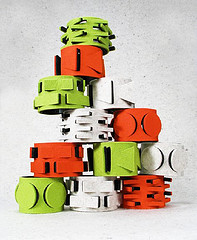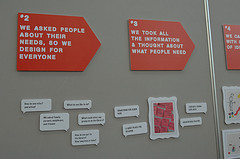“Design is inevitable. The alternative to good design is bad design, not no design at all.” (Douglas Martin)
I recently had the opportunity to participate in an excellent webinar about “Service Design” by John Wooden and J Hruby of Fredrickson Communications. Many of the principles that were shared for designing excellent service experiences correspond with my work positioning integrity as a practical strategy for organizations:
Use a whole perspective. John Wooden, Fredrickson’s Director of Usability Services, discussed the importance of designing service experiences with not just customers and service users, but those who deliver the service, in mind. If processes are easy for one group but not the other, outcomes will be less than optimal and likely even fail. Similarly, if a process has a slick front door via a website or application, but is really just a digitized version of a process that is outdated or otherwise inefficient, there’s only so much that can be done to make the experience a good one.
 The best product, service experience and organizational designs appeal to us physically, mentally, emotionally and even spiritually, or artistically – to the whole person. Apple product success is due not only to functional excellence, but to artful design and its “coolness” factor. If we must wait in line for a service transaction, an experience that is appealing – or at least not unpleasant emotionally and aesthetically is preferable.
The best product, service experience and organizational designs appeal to us physically, mentally, emotionally and even spiritually, or artistically – to the whole person. Apple product success is due not only to functional excellence, but to artful design and its “coolness” factor. If we must wait in line for a service transaction, an experience that is appealing – or at least not unpleasant emotionally and aesthetically is preferable.
Merriam Webster’s definitions for “integrity” include being “whole”, or “complete.” Those are important characteristics of not only design integrity, but of leadership and organizational effectiveness. How many times have organizations or leaders missed the mark because they neglected to adopt a “whole” perspective? Examples include neglecting key stakeholders, overlooking or discounting contrary opinions or missing critical market signals.
Form follows function. Whether designing a product, service experience or organizational structure, first be clear about intended use and outcomes. What purpose or purposes do we want a product, organization or service experience to serve? When embarking on a service redesign, it’s important to keep the ends in mind; likely they are some combination of improving user or provider satisfaction, increasing efficiency and reducing costs.
A large part of architectural integrity is whether a design suits intended purposes for a  building or office. Likewise, an organizational structure or chart reflects integrity when it serves intended purposes. An early critical step when I help clients consider organizational structure changes is to thoroughly articulate what the structural changes should accomplish. Alternative structures can then be evaluated against those desired goals. Using intended purposes or outcomes as design criteria will guide creative thinking into the most productive channels and contribute to design integrity
building or office. Likewise, an organizational structure or chart reflects integrity when it serves intended purposes. An early critical step when I help clients consider organizational structure changes is to thoroughly articulate what the structural changes should accomplish. Alternative structures can then be evaluated against those desired goals. Using intended purposes or outcomes as design criteria will guide creative thinking into the most productive channels and contribute to design integrity
Think alignment. A great product design and experience can be either reinforced or not reinforced by a service design and experience. Together, they determine perceptions of how a brand fulfills its promise. For example, my perception of an automobile brand is determined by not only the vehicle itself, but by how it is serviced by the dealer. The  quality of that experience is in turn determined by multiple interfaces, including a web site to schedule maintenance, the service desk, quality of the mechanical work, billing, car delivery and more. All of those interfaces need to be seamlessly connected in ways that consistently reinforce fulfillment of the brand promise. And a failure (as perceived by the customer) at any one of those points can adversely affect their perception of the entire brand experience. Just ONE sub-optimal interaction can lead to a lack of trust or some other form of dissatisfaction. I don’t know if this is really and truly grasped by many businesses.
quality of that experience is in turn determined by multiple interfaces, including a web site to schedule maintenance, the service desk, quality of the mechanical work, billing, car delivery and more. All of those interfaces need to be seamlessly connected in ways that consistently reinforce fulfillment of the brand promise. And a failure (as perceived by the customer) at any one of those points can adversely affect their perception of the entire brand experience. Just ONE sub-optimal interaction can lead to a lack of trust or some other form of dissatisfaction. I don’t know if this is really and truly grasped by many businesses.
Apple was one of the first, if not the first, to pay attention to ALL of the service interfaces, including packaging – another customer touchpoint. Pay attention to Apple packaging; it’s as elegant as the product inside.
Merriam Webster’s definitions of integrity also include “seamless”, “connected” and “united.” Steps and players all along a service or supply chain that demonstrate unity, connectedness and seamlessness in service to desired ends display design integrity. In the public sector especially this can be a HUGE issue, driven by silos and improper alignment of incentives with customer service.
Be authentic. Authenticity is a critical dimension of integrity; for products that includes uniqueness and originality. In the context of service design, Wooden and Hruby discussed  another important aspect of authenticity: being real about what is true about customers. That means not assuming what service users or providers need and want, but actually asking them and collecting objective data. While it’s true that customers can’t always articulate what they really want – sometimes they don’t know until you show them – the use of interviews and various ethnographic tools can help shed light on this. Whether designing a product or service experience, and for most other endeavors, we need to be careful about assumptions and test them. As Mark Twain said: “It’s not what we don’t know that will get us in trouble so much as what we think we know that just isn’t so.”
another important aspect of authenticity: being real about what is true about customers. That means not assuming what service users or providers need and want, but actually asking them and collecting objective data. While it’s true that customers can’t always articulate what they really want – sometimes they don’t know until you show them – the use of interviews and various ethnographic tools can help shed light on this. Whether designing a product or service experience, and for most other endeavors, we need to be careful about assumptions and test them. As Mark Twain said: “It’s not what we don’t know that will get us in trouble so much as what we think we know that just isn’t so.”
Be accountable. Being accountable includes accomplishing our objectives and fulfilling promises. As they say, “what gets measured get’s done”; that means that to accomplish service design objectives and any intentions, we need to collect appropriate measures. If the goals of service redesign are improved customer satisfaction and cost reduction, we need to measure results accordingly. Going back to the first principle, we also need to collect balanced measures that reflect a whole perspective. Achieving increased customer satisfaction and reduced costs while burning out service providers would not demonstrate integrity.
Things change. Design integrity of products, services and organizations requires attunement to changes that suggest modifications, and processes for revisiting designs to accommodate those changes.
How might you apply these principles for design integrity to:
Product design?
Service design?
Organization design?
Your life?
In my book Navigating Integrity – Transforming Business As Usual Into Business At Its Best, you will find many more ways that integrity in its broadest sense contributes to leadership and organizational excellence.
Design is the application of intent – the opposite of happenstance, and an antidote to accident. (Robert L. Peters)
The design process is really just Iterate, Iterate, Iterate. (Chris Clark)

Hi Al,
To your elements of accountability I’d like to add: knowing that risks and failure of yourself and others are part of work and thus life, and acting truthfully and with candor when deviating from delivering.
Al, thank you for the kind words about our webinar on service design. The idea of linking this concept to integrity is very interesting and I had not thought about doing that, but it makes sense. It relates to the idea that we tried to convey in the webinar (and that Peters states so succinctly in the quote at the end of your piece) that, whether intentional or not, an organization’s services will always have a design. The question is whether that design is fully intentional or accidental. I think the question you are asking is very important for organizations to consider: Is the design of our services, products, processes, and organizational culture part of one integrated whole? Reaching the goal of integrated design isn’t easy, but it’s definitely worthwhile.